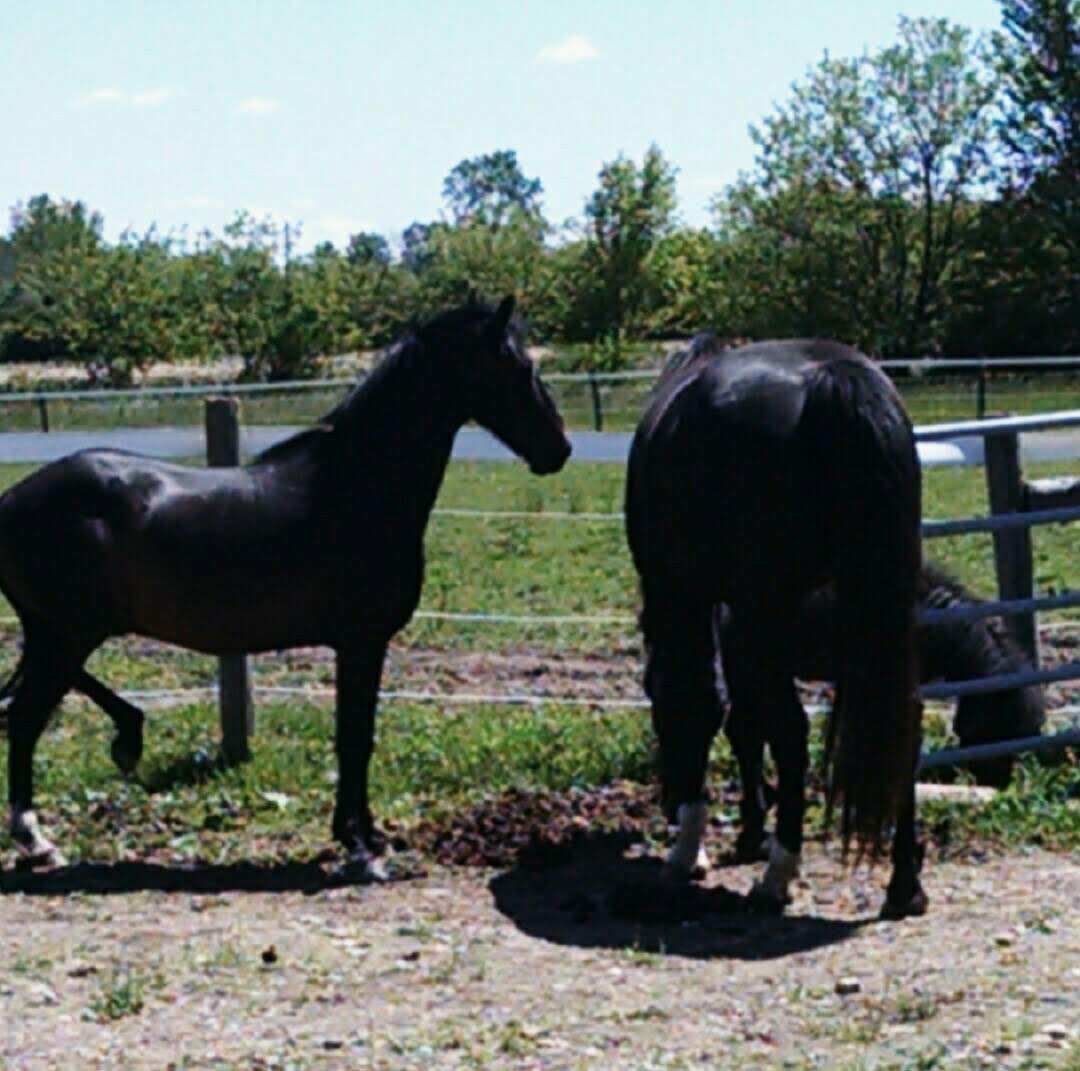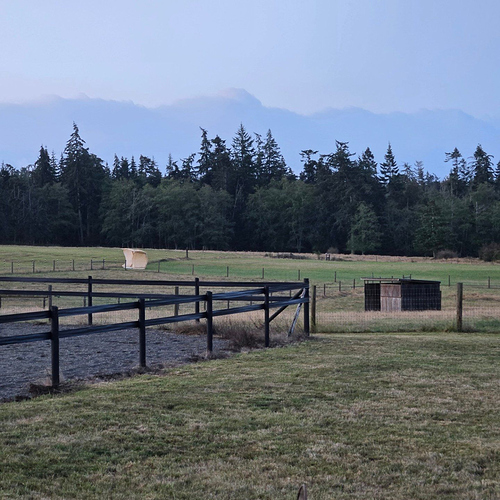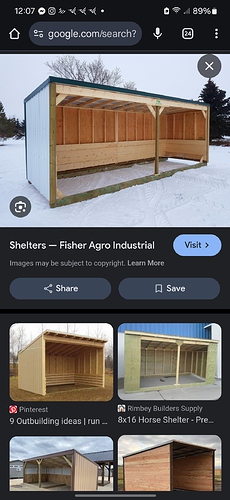We are buying a nice country house with lot of land for our critters. I’m starting to plan some works that have to be done before moving in.
First of all, we’ll have to fence the area. I’m thinking of a small sacrifice paddock with run ins fenced with solid wood that open on rotation on 3 big grass lots during the day. We have wolves here and I prefer to close the horses in the small paddock (with the free round bale) during the night. We’ll fence the grass paddocks with hot wire, any experience with the solar panel ones? I don’t now how to bring electricity to the hot wire system and I don’t like barbed wire (saw too many horses badly injuried).
Then, do any of you have those PVC run ins? The ones that look like big tents? I’ll have to check again with authorities but as far as I understood they won’t let us build any wood or brick run in, PVC ones would be accepted. We’ll also have a barn with two stalls in case of bad weather or horse illness but they are used to live outside H24 and they don’t like to be reclused
We use a solar panel fence charger from TSC for our poly tape fence. It works great! We’ve had no issues whatsoever with it and it’s very user friendly. My eyes glaze over at the mention of anything electrical and I was still able to figure it out easily
My 5ac farmette has about 3+ of those acres dedicated to my herd of 3: horse, pony, mini.
If you haven’t built your barn yet, IIWM, I’d leave room for added stalls.
I had a 36X36 pole barn built with 2 12X12 stalls.
With a 12’ aisle, that left me room for a possible 5 or even 6 stalls. I started with 2 geldings & in 2016 added a mini.
Neighbors were able to build a mini-sized 10X12 stall for the mini with around $200 worth of lumber.
I store 300+ small square bales on pallets across from the stalls - area measures 12DX24L.
This is my year’s supply of hay, so no shlepping bales in the dead of Winter.
I had a frostfree hydrant put inside the barn, so no frozen water supply. Heated buckets in each stall & a sinking de-icer in the 50gal barrel trough just outside the front slider.
Barn is surrounded in front by my drylot - ~50X150 - gates lead to pastures from the drylot.
Horses are out 24/7/365 with free access to stalls & pastures.
They rarely choose In over Out, though it’s not unusual to find all 3 hanging out in a single stall.
Makes my life sooooo much easier.
This morning, even though cool @51° & drizzly overnight, all 3 spent the night out.
Proof: not a single pile of manure in any stall. 
I fenced with 6" round wood posts, spaced @ 12’, 3 lines of coated tensile wire (top can carry a charge, but I’ve never made it hot) topped with 4" PVC rail. All of this is 20yrs old & aside from occasionally retensoning lines & replacing the odd staple, I’ve only had to reinforce 9 posts last Summer.
Had pros do this, but if you’re not an old lady like me, could easily be DIY.
Have fun & make things as easy on yourself as possible.
There’s nothing like sitting in your barn listening to horses nomming hay, in jammies.
Or clothes the Public would be horrified to see 
ETA:
Pic of my Herd of 3 in Summer 
(mini in the big pasture, just behind the open gate)
I have 3 TSC solar/battery electric fence units going for nine years so far. They have done OK, with two. caveats.
Battery life has been around three years, so they are not install and forget units. They do require significant disassembly to replace their big 6 volt batteries as there is no battery access door. It is not a difficult task though.
The on/off switch is on the bottoms of the units and all of mine corroded and stuck in the on setting after about two years. Not a big deal unless you need them powered off to work on the wire or tape, but you can just unscrew the ground
connection and leave the unit live while you work.
Location makes a huge difference on how effective solar chargers work. Cloudy locations, places prone to “grey” weather, may not provide enough lumens of light to keep solar powered things charged up.
Do wolves actually attack things in your neighborhood? If so, I would suggest a protective barrier fence outside your wood fences. This would be the net electric fences used with sheep, goats, birds, against marauding predators. You would want back-up batteries should the solar get under powered with stormy weather or other lack of sunlight. If wolves lack food sources (bad winter, deep snow) they might venture close to farms for food and a string of hot wire won’t stop them!
You might ask for an exemption on the building material for shed or stable. Why are wood and brick, metal sided structures not acceptable? Are not homes built using wood or brick? Plastic is pretty breakable, with shattered PVC having very sharp edges. Lots to tangle horse in should it get broken or knocked around. Also not real protective against wolves.
Check with local electricians about getting power out to the field/shed area, setting up an outlet for the charger and tank heater plugs. Might be a manageable cost, done professionally (meaning correctly) so you don’t have to worry about things working well. Put any buried wires in conduit to be better protected.
That was my first thought. Add that sun damage and cold winters and it’s just a recipe for disaster. I would never use a PVC shelter.
Are these shelters PVC or is it like rubbermaid plastic? Big difference…not sure what they are (“look like a tent?”)
I have seen hundreds of feet of PVC fencing melted to the ground after a brush fire while fencing across the road on wooden posts are charred but still standing and functional
I’d think the coating would melt off my fencing, but even that top rail has 2 wires embedded.
Hopefully fence would still be a barrier.
I always thought I might replace the wire with electrobraid, but now I need to investigate what the core is 
I’m happy that solar panel chargers work fine, one problem solved. It’s a sunny area, quite cold during winter for being here, maximum cold should be about -5° C during winter. Not a very snowy area but I foresee some inches during the coldest period of winter (about 10/20 cm).
@goodhors wolves of the area are not known for attacking horses and cattle (but they selfom attack calves and foals), they are pretty small compared to your wolves, big males reach about 30 kilos. My main concern would be them scaring horses and making them run and get hurt. I will have anyway a look to etectrified nets (I saw them used to protect sherpa and goats). I’m more worried for our dogs, so I want to fence our yard at least 2 meters high and maybe put a couple of lines of barbed wire on top.
In order to get power out to the fenced area I’d have to cross a public road (small and not busy at all), I’ll ask an estimate of costs.
That’s what the shelters look like
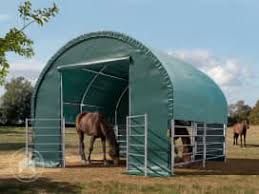
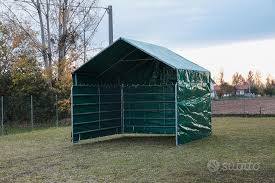
Italian laws are weird  it’s not that you owe land and build your things…the ratio is that a mobile shelter would be allowed, a permanent one not because it would be assimilated to building houses
it’s not that you owe land and build your things…the ratio is that a mobile shelter would be allowed, a permanent one not because it would be assimilated to building houses
@2DogsFarm the barn is already there, with 2 stalls I’d have enough room for hay too. It’s a solid ancient Building, made of wood.
Thanks, that clears up a lot of details.
Those vinyl shelters might not hold up in heavy wind.
A neighboring farm just put one up and a couple days later we had the outer edges of a tropical storm and next morning the outer skin/ vinyl disappeared.
Just gone.
Here, overall property taxes can be lower if a building is considered to be portable, therefore not permanent like a house. For instance, on our property, our well shed, hay shed and tractor shed are consider portable, even though they’ve been in position for many years. Our well and hay sheds were constructed from metal building kits, while our wooden tractor shed was built for us by a local man.
There are builders who specialize in constructing portable run-in sheds for horses, too, which are built off-site and trucked to the desired location. Is something such as that possible in your area?
Here’s an example of a company which does this; I’m not personally familiar with their work, but it may give you an idea of what I’m talking about:
That’s my main concern. I don’t known how really windy is the area, my plan would be to install the shelters in a clearing, protected by trees. I saw that a neighbour have these kind of shelters, I’ll have a talk with him about the wind
Oh wow, I’d love one of these! I never saw one but this doesn’ t mean they do not exist in Italy too. I’ll ask if they would be allowed First, many thanks, great advice!
You can build wooden ones on “skids” and call them moveable. We do that here to get around permitting requirements, anything bigger than 14x14 requires a permit, which takes for freakin’ ever AND you have to submit plans and etc etc. But skids? Not a permanent structure, so no permit required.
A neighbor’s Harbor Freight carport came over to visit this summer 
I also think a lot depends on your personal circumstances and what kind of critters you have. When I was building my farm, I was living alone (still am) and had no truly horsey friends. So I built my place that regardless of where they were, out or in, any random friend could manage to feed them (throw hay) and check water without handling them and I didn’t have to worry about anyone dying. Because my job is unpredictable and higher-risk than average, I knew this was something fell into the “hope it never happens but plan for it just in case” column. A lot of stuff with horses is like that. A friend’s weanling lived with me for a month after a serious injury because she has a nice set up with runs and paddocks, but absolutely no way to shut the baby into an area that was completely dry and mudfree.
My setup.is similar to @TheJenners.
Horses bring themselves in, separating into their “assigned” stalls.
Even a non-horsey person can (& has) feed & water without touching them or going into a stall, except for sliding the aisle doors open enough to put down a flake of hay.
I hung water buckets by the feed openings in the grilles, so they can be watered from the aisle without moving a bucket.
@TheJenners do you have a picture of a shed with skids? That could be and idea!
Where we are living now, we have our horses home but the set up is not clever at all. First we do not have a driveway neither to the house nor to horses. We quite a big paddock but there is not a real pasture because it’s mainly river sand and only a little grass grow.
We have a shed (wooden) but no real stall (it is possibile anyway to close half of it and use as a stall as we did when Paco was colicking last time. So this time I want to make it as easy as can be. We have a driveway and we can drive through all out land. As you said anyone will be able to check/feed/water horses without entering (now it’s not possibile, you have to enter the fence to reach hay and shed). There is a very reliable boarding barn (they also give lessons) just a couple of hours of riding from us (or 20 minutes drive) just in case we’ll need to leave them for a longer period of time. Neighbours are horse friendly people and it’s a rural area where people are still used to help each other in case of need, and I love this aspect.
Solar fence energizers are fine in most circumstances.
When I moved onto my property, I needed temporary shelter in a hurry. I bought a 12x20 metal carport from Lowes for about $1100. I added a plywood wall as a windbreak.
The plan was to repurpose the carport for tractor or trailer storage when I finally built a proper shed in that paddock. 3 years later, it’s still in the paddock… but it’s doing it’s job well and much sturdier than one of the tarp structure temporary shelters.
A former neighbor build a permanent shed (like a smaller pole barn) without a permit. When a building inspector discovered it and ordered it to be taken down, the neighbor took four old car tires and rims, nailed one on each corner, and claimed the shed was portable.
I doubt your Italian inspector would be as gullible as our local one was.

